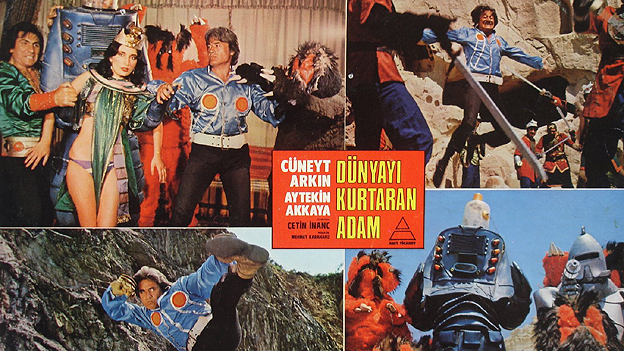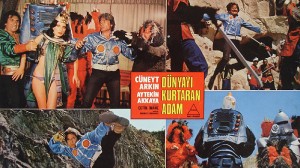From The Dark Knight Rises to The Amazing Spider-Man, superheroes dominate the box office at this time of year. But a long way from the million-dollar Hollywood films, there is another group of caped crusaders who have caught the imagination of film fans the world over.
The film opens with an image of space decked in twinkling Christmas decorations.
The Superman theme kicks in and the familiar S-logo floats over the top, looking rather hand-drawn.
Soon we are following Clark Kent set out on his adventures. Only the bespectacled man is not Kent at all, it is someone called Tayfun and he is living in rural Turkey.
He is the star of Supermen Donuyor, meaning The Return of Superman – a 1979 Turkish remake of Richard Donner’s 1978 classic.
That is just the beginning. From the 1960s to 1980s Turkish popular cinema – dubbed Yesilcam (Green Pine) – produced a large number of films that borrowed storylines and ideas from American blockbusters and pop culture. Some even lifted entire sequences and scores from Hollywood.
Many had a superhero or fantastic theme but the range is vast, from James Bond adaptation Altin Cocuk (Golden Boy), to a Turkish exorcist called Seytan (Satan).
There is also Badi (Buddy), which is a Turkish ET, and the film that has been dubbed the Turkish Star Wars, Dunyayi Kurtaran Adam (The Man Who Saves The World).
Watching these films is like entering a parallel universe – everything is familiar and yet totally different.
At times the film-makers appear to revel in the freedom of being able to take elements, ideas and characters from Western popular culture, add a pinch of Turkishness and then put them into a giant movie blender.
Take the 1973 movie Uc Dev Adam (Three Giant Men), in which Captain America and Santo the Mexican wrestler have to save the day. From a sadistic Spider-Man.
Captain America and Santo – go get the evil Spider-Man
They often sparkle with energy and creativity, though the directors lacked the budgets of their Hollywood counterparts.
We see the protagonist fly in Supermen Donuyor but it is done rather crudely over footage of Istanbul.
Continue reading the main story
There are Turkish versions of…
James Bond – Altin Cocuk (Golden Boy), director Memduh Un, 1966
Star Trek – Turist Omer Uzay Yolunda (Omer the Tourist on Star Trek), Hulki Saner, 1973
Batman – Yarasa Adam – Bedmen (Batmen – Bedmen), Gunay Kosova, 1973
Exorcist – Seytan (Satan), Metin Erksan, 1974
Superman – Supermen Donuyor (The Return of Superman), Kunt Tulgar, 1979
ET – Badi (Buddy), Zafer Par, 1983
Rambo – Korkusuz (Fearless), Cetin Inanc, 1986
The Man Who Saves The World opens with images of spacecraft lifted directly from Star Wars. Much of the music is from Raiders of the Lost Ark.
These low-budget movies are winning over 21st Century fans in Turkey and beyond. In the US, production company Dark Maze Studios has even put out an English-language version of the “Turkish Rambo” – which they have named Rampage.
Studio head Ed Glaser recalls the moment he first saw a clip of “Korkusuz”. Watching Stallone look-alike Serdar Kebapcilar rampaging through an enemy camp with an outrageous wooden rocket launcher left him “in awe”.
“I had to see the entire film. The problem was that there was no English version available,” says Glaser. “So after months of fruitless searching, I had the preposterous notion to release one myself.” Which he did in 2009, re-dubbing the film into English
Glaser explains that thanks to the net there is a fan-base for this genre in the US – where the films have been dubbed remakesploitation movies. Sites such as YouTube mean people are suddenly watching films that would never have been seen outside their home country.
“There’s nothing quite like them, and they’re often so bizarre and outrageous that you can’t help but be fascinated by them,” he says.
In Turkey these once-obscure movies have been rediscovered over the last 10-15 years and are today treated with “curiosity and amazement”, says Professor Kaya Ozkaracalar, an Istanbul-based film lecturer.
He recently hosted some of the broadcasts of the films during a season being run on Turkish network Star TV. Following the screening of Uc Supermen Olimpiyatlarda (Three Supermen at the Olympic Games), the title was trending on Twitter.
Utku Uluer says directors borrowed from US movies as they lacked the cash to realise their vision
“Tweets from the viewers were along the lines of ‘Have I had too much alcohol?’,” he says.
The films should be seen as more than just bizarre B-movie schlock, according to Utku Uluer, editor of Sinematik Yesilcam – a website dedicated to Turkish cinema culture. We should look at them as mainstream adventure movies that were created by ambitious directors facing massive budget limitations.
The motivation behind copying American output was partly due to distribution, or rather the lack of it, he says.
There was a hunger for films across Turkey but it was simply too expensive to get the American blockbusters to small cinemas across the Anatolian countryside. It was cheaper for directors to simply make their own versions of films.
Some were not remakes at all – they simply used special effects and soundtracks from American movies because they lacked the time and the money to realise their creative vision.
Continue reading the main story
The copyright issue
By Professor Kaya Ozkaracalar, Bahcesehir University, Istanbul
There is a technical breach of copyright laws in some of these films.
However, most of these movies were very low-profile productions. Simply put, they largely went unnoticed at the time of their original release.
Many played in a handful of remote cinemas and have become well-known only retrospectively.
But in one case at least they did not get away with it. The producers of Badi – the “Turkish ET” – were sued by the Turkish distributor of the American film.
The production of Badi had gathered some publicity in mainstream press and and its distributor had set up a modest but relatively wide release.
“For example, the ‘Turkish Star Wars’ is not Star Wars at all,” Uluer says. “The film-makers used some scenes from George Lucas’s epic but the story is totally different.”
Indeed it is. After the images of the Death Star and the Millennium Falcon, a voiceover relates the story of “two Turkish warriors” who have to save the world from evil.
We follow two excellently-coiffured Turkish gentlemen – it is 1982 – run around the moon-like landscape of Cappadocia in central Anatolia, kung-fu-fighting their way through a series of inventive creations – blue-headed robots, giant red-bear-like things, skeletons and zombies. It is rather fun.
Many of the films could have been lost forever, says Uluer, as they were not looked after at the time, with some reels even being melted down for their constituent parts.
In the 1990s small cinema clubs in Istanbul began to show interest in these gems and started hunting down the original films.
Interest broadened with the publication of 1999’s Turkish Fantastic Cinema, by film historian Giovanni Scognamillo and Metin Demirhan, a comic artist and collector.
Today, Uluer’s own site Sinematik Yesilcam continues to widen interest in the genre.
Uluer sees himself as an “archaeologist” of film and material from Turkish cinema’s fantastic history, uncovering relics to put on display for today’s viewer.
I leave him sifting through brightly-coloured, dusty posters of the Yesilcam period in a collector’s shop hidden in the dark nooks of Istanbul.
And I wonder what treasures he will uncover, and what movie gems the internet will continue to unearth.


